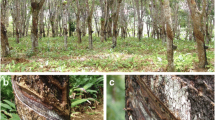Abstract
Cercospora caricis is of interest as a potential mycoherbicide for control of purple nutsedge, Cyperus rotundus, which is considered to be the world's worst weed. The genetic variation of a collection of Brazilian Ce. caricis isolated from Cy. rotundus was analyzed by using RAPD, RFLP with a telomeric probe, [TTAGGG]18 and sequencing of the ITS1-5.8S-ITS2 regions of the ribosomal RNA gene. The Brazilian isolates were also compared with a Ce. caricis isolate from Florida, USA and with some other Cercospora species. A cluster of isolates from the Brazilian cerrado region was identified showing high genetic similarity. In contrast, isolates originating in other geographic regions of Brazil were less than 50% and 25% related to the former group according to similarity estimates produced from RAPD and telomeric RFLP analyses respectively. ITS sequence analysis did not support taxonomic division of the Brazilian strains, but did confirm the distant relatedness of these strains to the Ce. caricis isolate from Florida. The data indicate a need for an extensive molecular survey of Cercospora species associated with the Cyperaceae.
Similar content being viewed by others
Author information
Authors and Affiliations
Additional information
Received: 12 July 2000 / Accepted: 5 September 2000
Rights and permissions
About this article
Cite this article
Inglis, P., Teixeira, E., Ribeiro, D. et al. Molecular Markers for the Characterization of BrazilianCercospora caricis Isolates. Curr Microbiol 42, 194–198 (2001). https://doi.org/10.1007/s002840010203
Issue Date:
DOI: https://doi.org/10.1007/s002840010203




